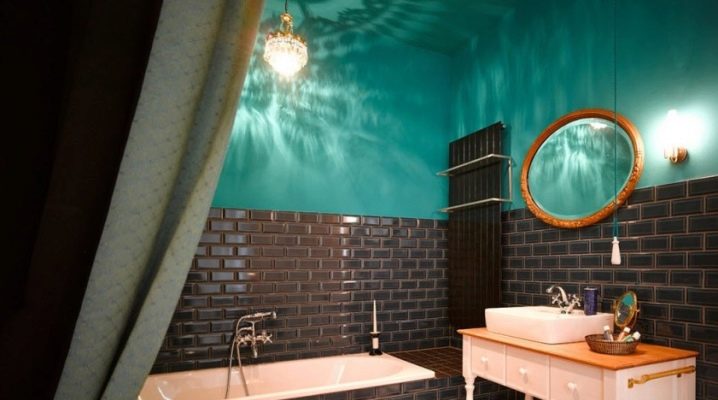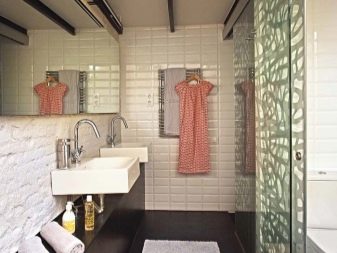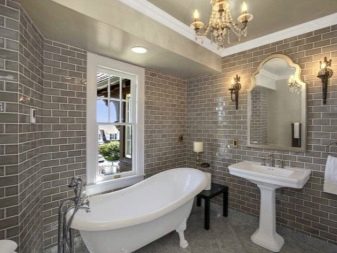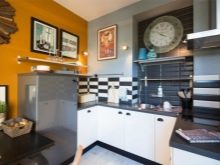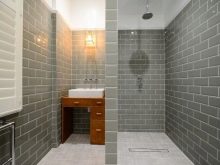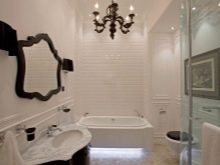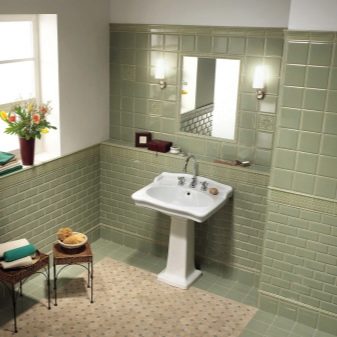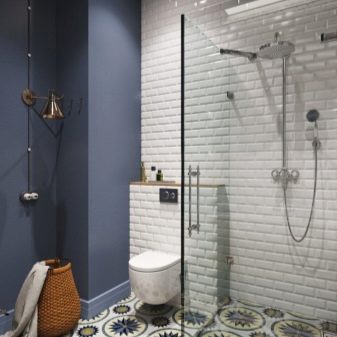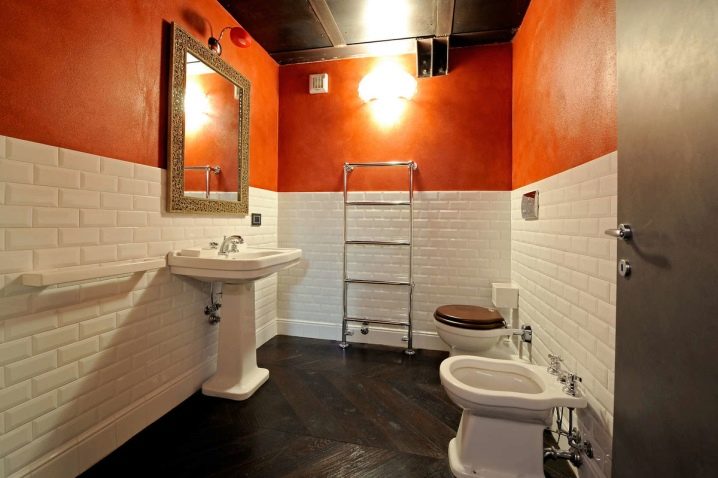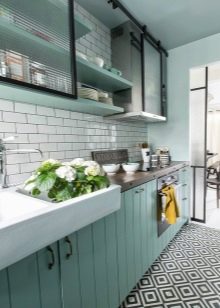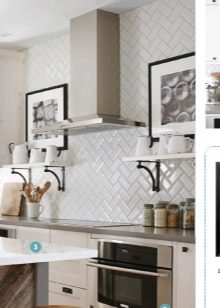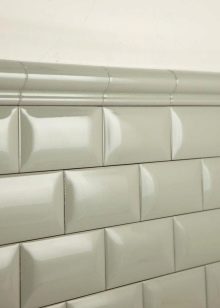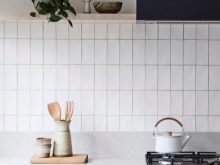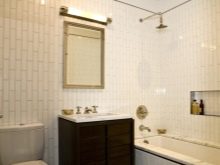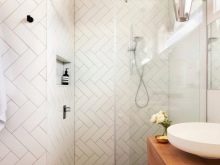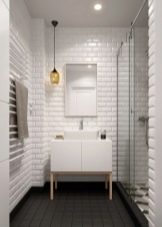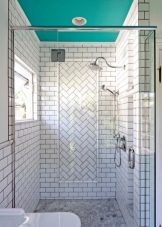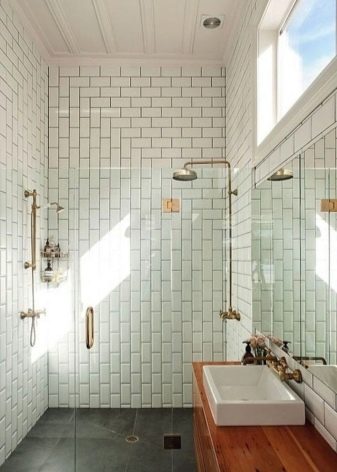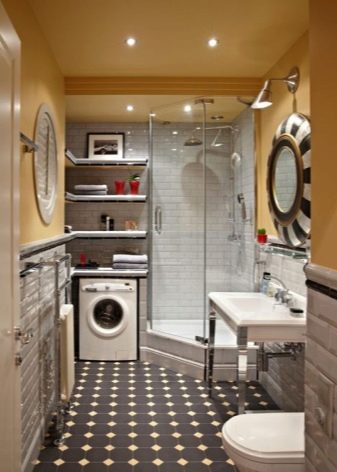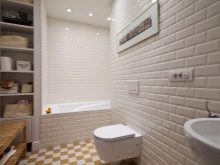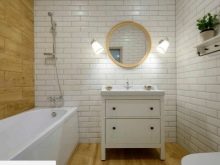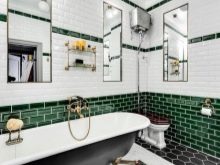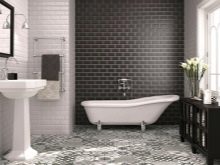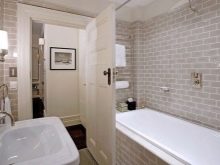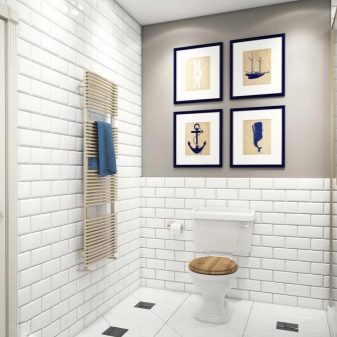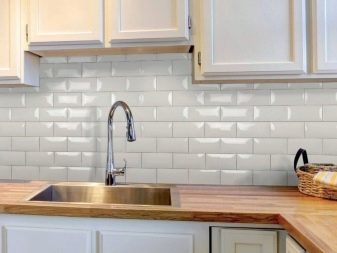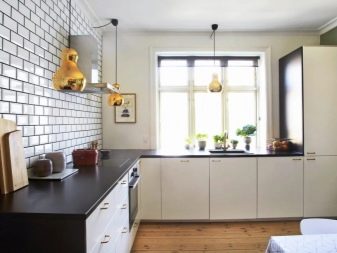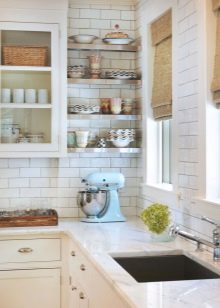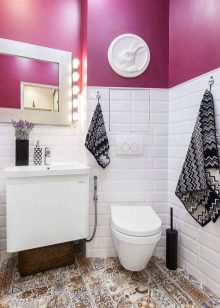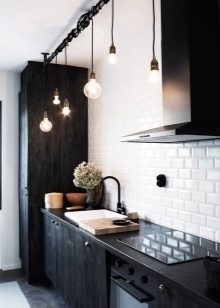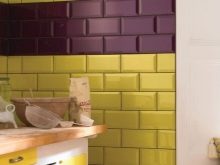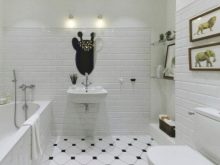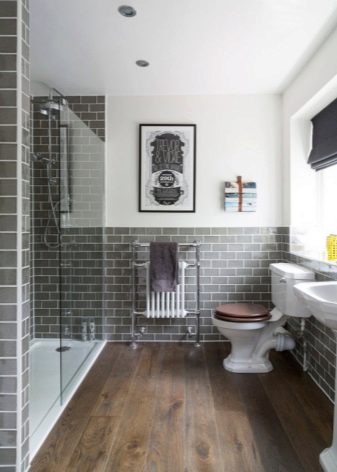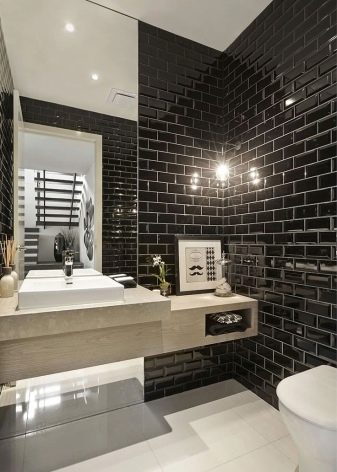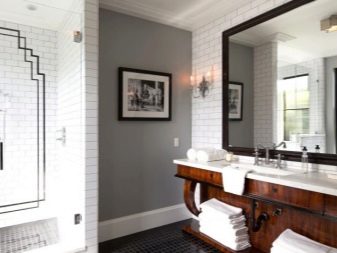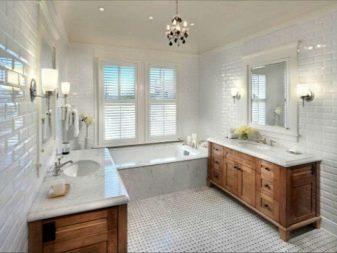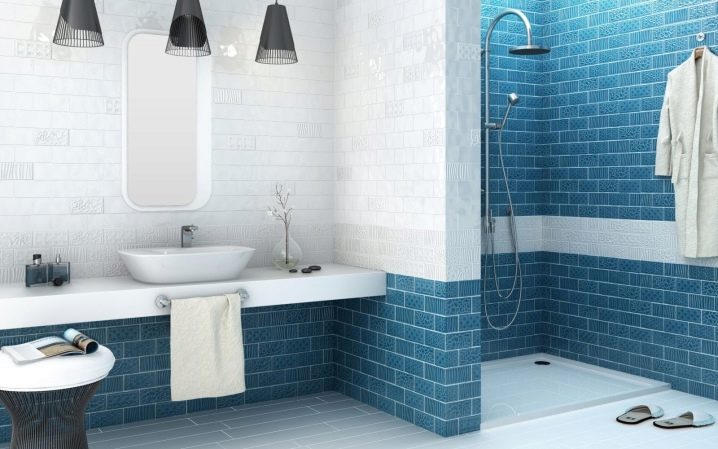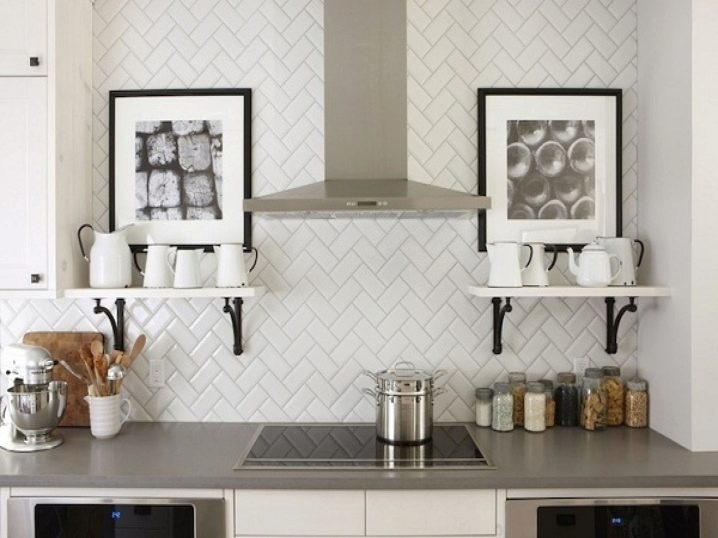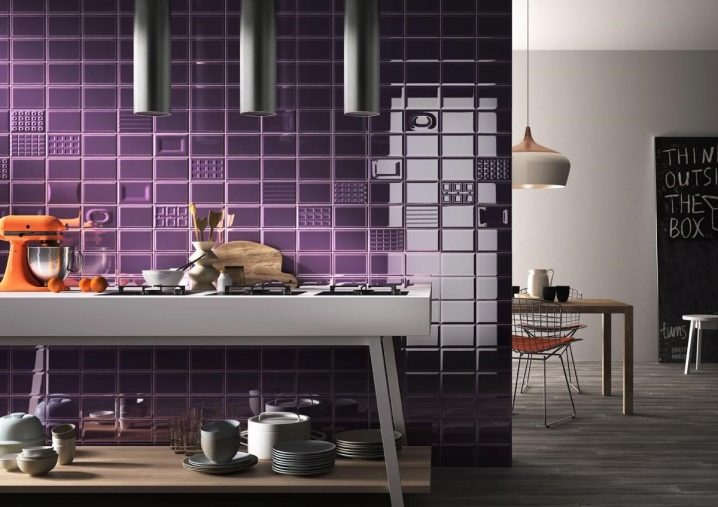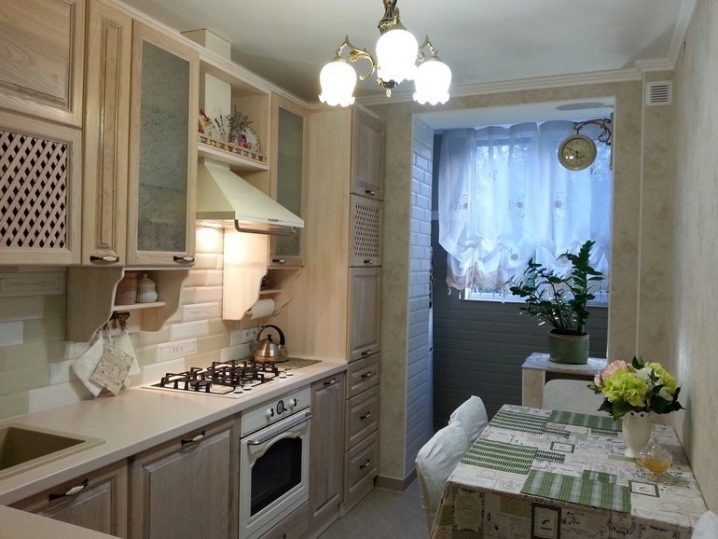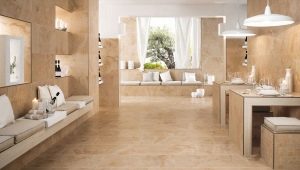Tile "pig" in interior design
Tile "hog" - is a fashionable type of ceramic tiles, which has not lost its relevance for several decades. I use it both for facades, and for interior work.
Special features
The history of this finishing material begins in 1900. At that time, “kabanchik” was called a facing tile for exterior work. She had an elongated shape like a brick, if you put it flat. At that time, facades of buildings in modern style were tiled with such tiles.
Also this type of tile is popular in the Scandinavian countries, from there it came to the interiors of other countries.
Today, "pig" began to call any clinker tiles - it can be of any size and color, but should have a solid color and an elongated shape, close to the size of a brick. At the same time, beveled chamfers give this ceramics a more lively and original look. This tile is used for interior work, and for facades should be taken special clinker ceramics without chamfers.
This tile has a lot of advantages:
- The elongated narrow shape perfectly hides some of the irregularities of the walls;
- unlimited service life (at the correct laying and operation);
- strength;
- withstands temperature fluctuations;
- not afraid of moisture;
- it can be cladding the walls in any room.
The cost of the tile depends on the size, color, and manufacturer. If you need to save money, you can purchase wall panels "under the pig"imitating such laying of a tile.
Most often, the panels are made of high-strength plastic, plexiglass or plexiglass coated.
Dimensions
The standard sizes for the hog are 7.5x15 cm, 10 by 20 cm and 15x30 cm. But in addition, there are other sizes - wider or narrower and longer, for example, 30x10 cm.
Wall ceramic tiles in the form of bricks suitable for almost any interior in any room. The kitchen apron can be laid out with a small neat "pig" of a standard size. The wall in the bathroom or in the style of a loft - tile 10x30 cm, which will look quite interesting, is also practical. Based on the parameters of the tile, should be consideredthat its large size visually reduces small rooms in area. Therefore, in small rooms should be laid tiles of standard or small size.. In the spacious rooms you can put both standard and large "pig". There are also special small bricks for small aprons in the kitchen.
Their size ranges from 10.5 x 5 cm to 11.5 x 7 cm.
Textures and Design
As mentioned above, tiles “hog” can be laid out the walls in any room: kitchen, bathroom and toilet, dining room. In the kitchen, this tile occupies the traditional place of the "apron", and in the bathroom they can lay out all the walls.
There are several styling methods:
- brickwork: the classic way, easy and versatile. It is only necessary to strictly control the horizontal lines so that there is no distortion;
- herringbone - in this embodiment, the tile is laid at an angle of 45 or 90 degrees. Requires accuracy and endurance;
- stacking - styling comes from the Scandinavian countries. The tile is laid in a simple horizontal pattern, docking to each other. To the wall did not look boring, you need to use a contrast grout;
- stack vertical - the same as horizontal, but requires skill and careful execution;
- vertical stacking with offset - "Bricks" laid out in the classical manner, but vertically;
- diagonal - an original and interesting type of masonry, suitable for both the apron and the walls in the bathroom.
Choosing a method of laying, you should consider some nuances: docking tiles at the corners requires a lot of attention. If there is a chamfer on the tile, then gently sawing it at 45 degrees for the outer corner of the walls is problematic. To avoid chips, the backing up should be done with a diamond grinding wheel at a low speed.. Inside, grind tiles should be a circle on the stone, and then you need to check their verticality. "Hog" you need to start laying from the junction of the walls, carefully adjusting the horizontal and vertical lines.
It is much easier to file a tile without chamfers, but here it is also necessary to ensure that the glaze does not crack. By the way, this “hog” should be laid out with sufficiently visible inter-tile seams. Classic bevel tiles can be laid on the wall in a seamless way. For this Docking tiles should be perfect, and the grout is matched to the color of the tile.
The texture of a modern hog can be completely different: the tile can be smooth and glossy, matte, specular, aged, rough, coated or colored. Shades - absolutely any, but the leaders are colors such as white, black, red, beige. In addition, today ceramic "bricks" of green, blue, yellow, orange tones appeared. Designers pay attention to interesting variants of blue, turquoise, violet and milky shades.
Marble as a texture and pattern on such a tile is another trend.
Manufacturers
Ceramic tiles "hog" can be found in the collections of Russian and Spanish manufacturers. Moreover, these two countries are considered the leaders in the production of such tiles. A huge selection of ceramics with a chamfer is, for example, the factory Monopole Keramica. Russian brand Kerama marazzi can be found "hog" in such collections as Vog from Azori, "Gamma", Cersanit, "Accord", "Campiello", "Mattone", "Butterfly".
The factories offer tiles of classic white or unusual fashionable shades - pistachio, blue-green, milky-yellow.In addition to the "bricks" in each collection there are decorative inserts with a pattern, borders.
You can choose a one-color version or combine two contrasting shades.
Spain, as a rule, offers the most intense and interesting in terms of color options. This is due to the local color. Russia also produces a stylish classic "hog", which is suitable for most interiors in our country.
In addition to coloring, hog from different collections differs in texture: glossy, matte, coated, figured inserts, ribbed and so on.
The sizes of the tiles are different for both manufacturers. Russian companies, in particular, Kerama marazzi offer options 85h285 mm. Spain produces tiles of 15x7.5 cm, 10x20 cm, and Poland offers, in addition to the standard, options of size 24.5x6.58 cm.
If we talk about the cost, then foreign tiles will be more expensive, but not because of the quality, but because of transportation. Russian high-quality manufacturers comply with the same technology, but the cost is lower. Although many users who have already gone through repair work, argue in the reviews that the Spanish “hog” of white is much “whiter” than the domestic one.But this is a matter of taste and personal preferences, as there are many shades of white and everyone will like this or that option.
Reviews on the quality of a tile also vary greatly. Users advise those who want to save money to purchase Russian tiles, and if originality, durability and quality are needed, then it is worth buying foreign options. By the way, apart from Spain, the “hog” is produced by Italian and Polish factories. In the season of sales can be profitable to purchase these options.
Also, discounts on ceramics are distributed when there are very few tiles left in the collection.
How to choose for different rooms?
Usually “hog” is chosen for the design of a kitchen apron - this type of tile is practical, does not require special skills when laying (with the exception of complex types), it looks fresh and interesting. Tile, lined with brick, suitable for almost any style of kitchen and headset.
To make this pottery happy as long as possible, some rules should be taken into account when laying it.
- To reduce the gaps in the vertical joints, as well as to make the baseboard fit most closely to the apron, it should be laid on the bottom or top of the facet, and not on the center of the tile.
- When making apron markings, you should take into account the thickness of the tabletop, the height of the plinth, the size of the tile and decor, if any, as well as the size of the bevels on the "hog".
- It is better to make the tile joint using epoxy grout - it is easier to wash it, and it does not lose color. The seam should not be too thick.
For the kitchen is better to choose glossy tiles without matte decoration or spraying, especially in the area of the hob. The glossy smooth surface is easier to clean off droplets of fat, sauce, and the like, and the matte tile will become untidy over time.
Toilet and bathroom - two more types of rooms in which it is possible to put a “hog”. Any kind of tile will work here.. It can be matte bricks of several shades, the traditional snow-white version, translucent tile of pastel shades and so on. The bathroom or the toilet looks rather unusual, the walls of which are lined with glossy black tiles. The seams should be made white.
Grout also need to choose epoxy.
In large rooms, "pig" is better to lay out the classic way with an offset - there is no risk that horizontal lines will “float”.For a small toilet, you can choose a diagonal laying on the wall.
Another tip: it is worth buying tiles with a margin of about 10% of the total. Indeed, when stacked in various ways, a part can deteriorate.
In addition, the walls before laying should be aligned and covered with a special tool for mold. This is especially important in rooms with high humidity. As for the seams, professionals advise to observe a thickness of 2 to 5 mm.
As a front tile it is better to choose a special "hog" - a clinker tile., light in weight and varied in texture and color. Such tiles, as a rule, are made of natural stone, different types of special clay. This facade material has a lot of advantages: the tile is resistant to changes in weather and precipitation, durable and original. "Hog" can be smooth or textured, matte or glossy. Clinker tiles can hide wall irregularities and it is also very easy to lay.
You can lay out the entire facade of the building, or to decorate the walls only to half, put a picture - in any case, the building will look more advantageous.
Beautiful examples in the interior
Today, the hog can be found in various design projects: it is popular in the Scandinavian style, as well as loft, industrial, Provence and modern. To enter such a tile into any interior is easy, the main thing is to follow the style and complement the decor with the necessary details and decor.
For example, a loft-style bathroom and toilet imply brickwork, concrete surfaces, bare metal pipes. A white “hog” without chamfers, laid out in a simple offset manner, will look good with contrasting, dark seams. A small sink, a tabletop made of tin and iron legs will competently complement the interior. Bath is better to choose a regular, steel and make a box under it, lined with the same tile.
The Scandinavian style is like a loft, but it is softer and has more textures in it: the snow-white color of the walls, sinks, bathtubs, furniture made of natural wood, the absence of unnecessary details. Here you can use glossy white tiles with bevels, which can be laid either in the usual way with offset or without offset.
Originality will add wood: cabinets under the sinks and shelves for towels.
If such interior options are not for you,then you can use the tile in two contrasting colors and with a pattern in a modern bathroom: lay out the walls with white and blue hues, where white is the top and blue is the bottom, use fashionable forms of plumbing and interesting lamps on the cords.
If we talk about the kitchen apron, then there are more options. A white “hog” lined with “herringbone” will be well combined with monochrome objects - vases, jugs, appliances. A white set and a gray tabletop without a picture will perfectly complete the picture.
Bright and glossy tiles with decorative inserts will look boldly in a modern kitchen. Monochromatic painted walls of a contrasting and calm shade here will favorably emphasize a part of the wall from such a tile. The room can be supplemented with a large graphic drawing board, furniture made of natural wood in the style of minimalism, interesting chairs with unusual backs, bright pillows.
A classic kitchen without decorating can also be decorated with a hog. Here an apron made of long matte bricks of beige shades will perfectly refresh a strict and aristocratic interior.
You can choose a semi-gloss tile, which feels like a natural stone. A light set with figured handles, flowers in ceramic vases, decor with elements of Provence - everyone will like this kitchen.
Variants of using tiles "pig" in the kitchen, see the following video.
